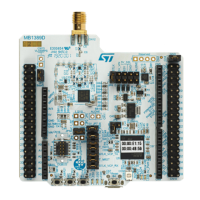Direct memory access controller (DMA) RM0453
458/1461 RM0453 Rev 1
The request/acknowledge protocol is used when a peripheral is either the source or the
destination of the transfer. For example, in case of memory-to-peripheral transfer, the
peripheral initiates the transfer by driving its single request signal to the DMA controller. The
DMA controller reads then a single data in the memory and writes this data to the peripheral.
For a given channel x, a DMA block transfer consists of a repeated sequence of:
• a single DMA transfer, encapsulating two AHB transfers of a single data, over the DMA
AHB bus master:
– a single data read (byte, half-word or word) from the peripheral data register or a
location in the memory, addressed through an internal current peripheral/memory
address register.
The start address used for the first single transfer is the base address of the
peripheral or memory, and is programmed in the DMA_CPARx or DMA_CMARx
register.
– a single data write (byte, half-word or word) to the peripheral data register or a
location in the memory, addressed through an internal current peripheral/memory
address register.
The start address used for the first transfer is the base address of the peripheral or
memory, and is programmed in the DMA_CPARx or DMA_CMARx register.
• post-decrementing of the programmed DMA_CNDTRx register
This register contains the remaining number of data items to transfer (number of AHB
‘read followed by write’ transfers).
This sequence is repeated until DMA_CNDTRx is null.
Note: The AHB master bus source/destination address must be aligned with the programmed size
of the transferred single data to the source/destination.
13.4.4 DMA arbitration
The DMA arbiter manages the priority between the different channels.
When an active channel x is granted by the arbiter (hardware requested or software
triggered), a single DMA transfer is issued (such as a AHB ‘read followed by write’ transfer
of a single data). Then, the arbiter considers again the set of active channels and selects the
one with the highest priority.
The priorities are managed in two stages:
• software: priority of each channel is configured in the DMA_CCRx register, to one of
the four different levels:
– very high
–high
–medium
–low
• hardware: if two requests have the same software priority level, the channel with the
lowest index gets priority. For example, channel 2 gets priority over channel 4.
When a channel x is programmed for a block transfer in memory-to-memory mode,
re arbitration is considered between each single DMA transfer of this channel x. Whenever
there is another concurrent active requested channel, the DMA arbiter automatically
alternates and grants the other highest-priority requested channel, which may be of lower
priority than the memory-to-memory channel.

